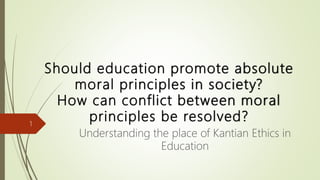
Should education promote absolute moral principles in society(1)
- 1. Should education promote absolute moral principles in society? How can conflict between moral principles be resolved? Understanding the place of Kantian Ethics in Education 1
- 2. Some basic Comparisons with prior theories Theory of Immanuel Kant is opposed to both consequentialist /utilitarian theory and egoistic or subjective positions. Kant believed that ethics can be organized using a single principle, one that is a source of our duties and responsibilities. Morality is not a question of numbers, our own or that of the greatest number. 2
- 3. You cannot define human life by calculating consequences. Something is not right or wrong on the basis of the circumstances around it. Morality is a matter of following Absolute rules. Theory associated with divine command but has nothing to do with God as a theory. 3
- 4. The basis of Kant’s theory – the good will Theory exclusively relies on rational argumentation. “Reason requires us to do certain things and refrain from doing other things” Hence, theory founded in Practical Reason and not theoretical reason Structuring the argument: Human beings are rational They have theoretical knowledge enabling them perform complex mental tasks (Maths, Logic) They are endowed with practical reason helping them in their quest to become “good people Determination to do good is referred to as “the good will” 4
- 5. The place of imperatives in Kantian thinking What is an imperative? What is a hypothetical imperative? What is a categorical Imperative? Doing our duty means always obeying certain absolute or compulsory laws or commands or imperatives. Imperatives worth of moral consideration are the Categorical imperatives. These are superior and as such are sources of Moral duty. 5
- 6. The place of reason in determining what is ethically right The ethically right is determined by asking: what would be naturally right for us to do by applying reason What would happen if we made a particular act UNIVERSAL? What rule/maxim would we follow? Would we be willing to allow everyone do it? 6
- 7. 1st Categorical Imperative (Universalisability test) Act only on that maxim whereby you can at the same time will that it should become a universal law (Act as if the maxim of your action were to become by your will a universal law of nature) Consider the following in view of the principle: Lying, murder, theft, “permitting these would become irrational. Concepts such as truth, property, and meaning itself would become meaningless” 7
- 8. 2nd Categorical Imperative Act so as to treat humanity, whether in your own person or in that of any other, always as an end in itself, never as a mere means. (Rational beings … ought always to be esteemed also as ends, that is, as human beings who must be capable of containing in themselves the end of the very same action) Follows the idea that human beings are rational/have the power of reason, autonomous/free, have desires and inclinations and as such are self-legislating agents. Understanding arises from the intrinsic nature of human beings as dignified and valuable in themselves and not by virtue of some utilities we can derive. 8
- 9. 3rd Categorical Imperative THE PRINCIPLE OF AUTONOMY The premise of all morality is autonomy Freedom is unique to the will of a rational being Generates the ability to will or author an action as law. Reason enable the movement towards the universal law I can only will an action as law if I respect the rationality of others Human beings only become differentiated by virtue of the good will or bad will motivating their actions 9
- 10. Should education promote absolute moral principles? A Kantian perspective The value of human being is above everything else. Why? People have desires and goals and other things have value for them in relation to their projects. Mere things have value only as a means to the ends/purposes of human beings. Their value is in human ends. Human beings have intrinsic worth or dignity because they are rational agents (capable of making decisions, setting own goals, guiding their conduct by reason) Kant’s moral law is the law of reason Without rationality the moral fabric of the world would disappear 10
- 11. Implications on how human beings deal with each other Treating human beings as end-in-themselves means respecting their rationality People should never be manipulated or used by others to each their ends no matter how good or noble those purposes are. The only way that moral goodness can exist at all in the world is for rational creatures to understand what they should do, acting from a sense of duty. 11
- 12. Problems with Kant’s the 1st formulation of his supreme principle of morality The idea of abstract inflexible moral rules is not an attractive one – moral beings doing their duties even if unpleasurable is difficult to hold. Understanding rules requires that we understand when and under what circumstances exception are allowed. NO indication on how conflicts between moral principles may be resolved. 12
- 13. How does the categorical imperative relate to contemporary issues such as: Abortion Punishment Treatment of non-humans Euthanasia 13
